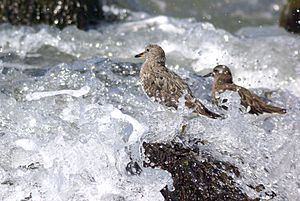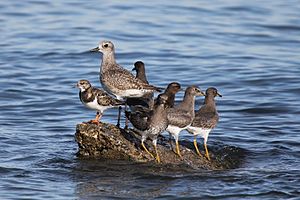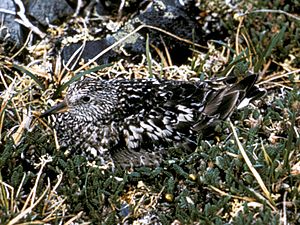Surfbird facts for kids
Quick facts for kids Surfbird |
|
|---|---|
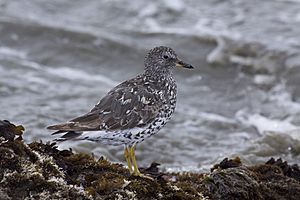 |
|
| In worn breeding plumage | |
| Conservation status | |
| Scientific classification | |
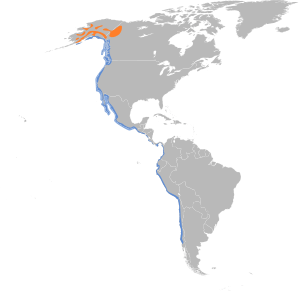 |
|
| Synonyms | |
|
Aphriza virgata |
The surfbird (Calidris virgata) is a small, strong wader bird. Waders are birds that often walk in shallow water or on wet ground to find food. This bird belongs to the sandpiper family.
Surfbirds have a short, dark bill and yellow legs. They also have a black band near the end of their white back. When they are ready to breed, their feathers (called plumage) are brownish on the head and chest with dark streaks. Their belly has dark spots, and their upper parts are dark with some rust color on their wings.
In winter, or when they are young, surfbirds are mostly gray on their upper parts and chest. Their underparts are white with some streaks.
Contents
Where Surfbirds Live and Travel
Surfbirds make their nests in rocky tundra areas. Tundra is a cold, treeless plain, usually found in places like Alaska and the Yukon in Canada.
The female surfbird lays about four eggs in a small dip on the ground. She lines this nest with plants. Both parent birds help take care of the young. The young birds find their own food.
These birds are known for their long migrations. They fly all the way to the Pacific coasts of North and South America. They can be found from southern Alaska down to Tierra del Fuego, which is at the very tip of South America!
What Surfbirds Eat
When surfbirds are on their nesting grounds, they mostly eat insects. They also eat some seeds.
At other times of the year, they eat mollusks (like snails or clams) and crustaceans (like crabs or shrimp). They find this food along the rocky coasts where the ocean waves crash. You can usually see them in small groups, often with other birds called turnstones.
The song of a surfbird sounds like a whistling tee tee tee.
How We Learned About Surfbirds
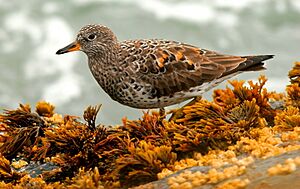
The surfbird was first described in 1789 by a German scientist named Johann Friedrich Gmelin. He studied a bird that was found in Prince William Sound in Alaska. This happened when Captain Cook visited Alaska in 1788.
For a long time, people thought surfbirds were closely related to turnstones. They even had their own special group name, Aphriza. However, newer studies show that surfbirds are actually very similar to the red and great knot birds. Because of this, they are now placed in the same group, Calidris. In fact, the great knot looks a lot like a bigger surfbird with a longer bill!
There is only one type of surfbird, meaning it does not have different subspecies.
What Does a Surfbird Look Like?
The surfbird is a large sandpiper. It reminds some people of turnstones or the great knot. It is about 23 to 26 centimeters (9 to 10 inches) long. It weighs between 133 and 251 grams (about 4.7 to 8.8 ounces). Male and female surfbirds look alike, but females are usually a little bigger.
Surfbirds have their special breeding plumage from March to August. During this time, their heads, necks, chests, and bellies are white with black streaks. The top of their head, called the crown, is rusty colored. The streaks become less noticeable lower down on their body.
Surfbird Reproduction
We don't know a lot about how surfbirds breed. They arrive at their breeding areas in early May. By then, the snow has usually melted because of strong winds in these open nesting spots.
Their nests are usually on slopes that face north or west. The nests are simple dips in the ground. They are lined with lichens and sometimes a plant called Dryas (mountain avens). Scientists believe that surfbirds defend their nesting areas and that one male and one female bird stay together to raise their young.
A female surfbird usually lays four eggs. However, sometimes smaller groups of eggs are found. The eggs are buff-colored with gray or purple marks. They are about 43 by 31 millimeters (1.7 by 1.2 inches) in size. Both the male and female birds incubate (sit on) the eggs to keep them warm. This incubation period is thought to be between 22 and 24 days.
See also
 In Spanish: Correlimos de rompientes para niños
In Spanish: Correlimos de rompientes para niños



